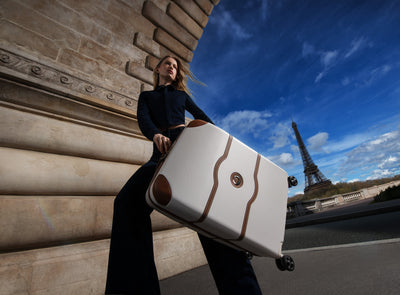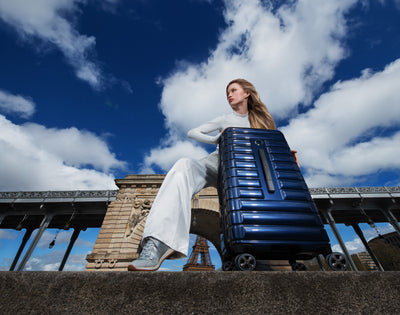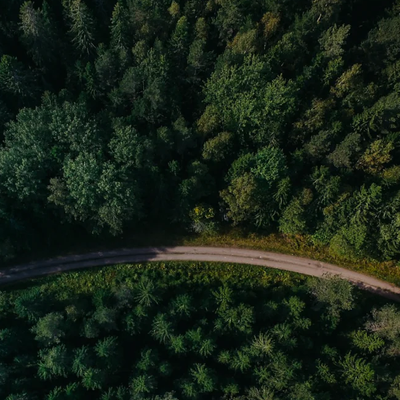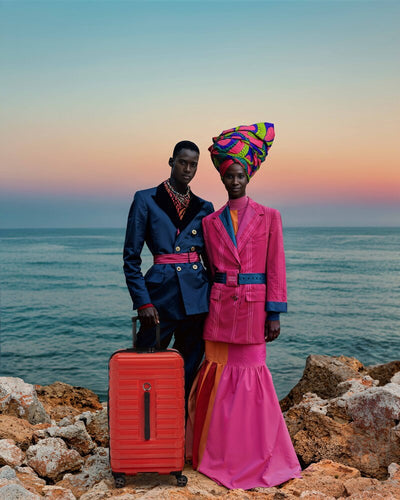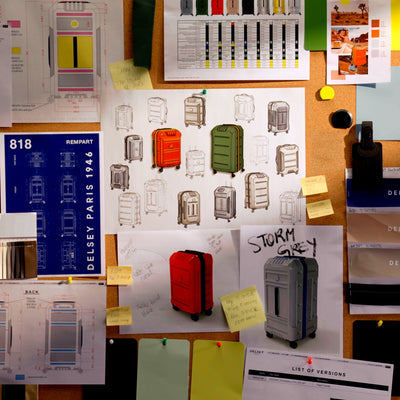Yolo & Delsey’s 10 Favorite Places in France
DELSEY PARIS has partnered with the premium travel magazine YOLO JOURNAL to bring you monthly travel inspirations to the most beautiful places in the world. Yolanda Edwards, founder of Yolo Journal, will share with you her favorite places and secret addresses.

Bordeaux
Just a two-hour TGV from Paris, this elegant city is reminiscent of the City of Light, but, on a much more manageable scale. Designed by Haussmann, it has his signature 19th-century architecture, boulevards, beautiful parks and squares, but you can walk all the charming little quartiers, from one end to the other in about 45 minutes (but that’s if you don’t stop along the way, which you will!).

My favorite neighborhood is Rue Notre Dame in the Chartrons which is filled with antiques shops, sweet little bars and the best bakeries–it’s the quintessentially perfect main street and square, without anything overtly commercial. I also love Allée de Tourny, where I suggest to start at the opera house, walk past the historic double-decker carousel and L’Intendant, an excellent wine shop. A few doors down, a wildly opinionated old lady runs a perfumery with a little hand-painted sign. Just down from that is Les Noailles, a brasserie that we love for its classic oysters and sole meunière. And just beyond that is my favorite little flower shop, Sadia Fleur, which always has buckets of hydrangeas, irises, or whatever is in bloom spilling out onto the street. Next door is the most perfect chocolate shop, Cadiot-Badie. It’s just one jewel after another, beautifully preserved.


Cassis
This charming Provencal fishing village in the South of France is picture perfect; pastel-hued seafront buildings and a harbor filled with equally colorful fishing boats. The five star Hotel Les Roches Blanches is the best place to stay–a splurge for sure–but it has the best location, just a short walk into town, a great pool overlooking the sea, stellar food, lovely and comfortable rooms, and definitely a very chic access to the sea. Eat at La Poissonnerie Laurent on the port—get the moules Provencale and fries, and afterwards wander the cute cobblestone streetoff the port. Don’t leave without exploring Les Calanques National Park.



Côte Fleurie
Just a two hour train ride from Paris is this stretch of Normandy coast, which has some great villages to visit. Trouville, the first stop on the train, has been a favorite seaside resort since the 1800s, and was a favorite subject of Monet. Lunch at the legendary Les Vapeurs is a must, as is a walk on the beach. Stay at the small and antique filled Hotel St-James, or in Deauville just down the road, at the Normandy Barriere. Heading west is Port-en-Bessin–another favorite on this coast–a sleepy fishing village, and a great place to situate yourself if you want to visit the D-Day beaches, or nearby Bayeux with its famed tapestry. Stay at Le Chenevriere, a lovely chateaux about 10 minutes from the sea, with a great garden and lawns to run around–perfect for kids. Le Bistro d’à Côté is the best seafood spot in town–it’s beloved by locals who don’t care that it isn’t right on the harbor. Honfleur, further east, is a small, elegant 11th century town on a harbor, that is incredibly beautiful. Stay at the Hotel du Dauphin des Loges, or just outside town at Hotel Le Chaumiere, which has huge rooms, lovely views, big grassy areas to run down to the sea, and a delicious breakfast. If you have a car, don’t miss Etretat which is 45 minutes away, and has the most beautiful cliffs (Monet was a fan!), pebble beach, and charming
town.
Ile de Re
Arguably the most picturesque island in the country, with 10 lovely villages scattered across it–with bike paths connecting them all. The first thing you do once you arrive is rent a bike–because this is the only way to really experience the magic of the island! Start your day at a village market (the one in Loix is excellent with a great vintage linen seller, but there’s the ancient 12th century food market in La Flotte that isn’t to be missed!), then head to one of the sandy beaches for the day. Lunch at Ré Ostrea, an oyster farm with a restaurant right on the water, is our favorite–where you can sit barefoot facing the sea and eating the tallest seafood tower, washing it down with the local white wine. Along the bike paths (at least between St-Martin-de-Ré and Loix), you’ll pass several salt stands, where you should definitely pick up a bag of salt. Stay at Le Lanternon, a small inn just off the St-Martin-de-Ré harbor, with thoughtfully considered decor and a pool, recently opened by a lovely couple who moved here from Paris. Don’t miss Le Magasin de la Republique, a store with an excellent curation of vintage furniture, and new design and clothing as well. Ars-en-Ré is much quieter than St-Martin-de-Ré, and is one of the most beautiful little villages, with a great place to stay, Le Sénéchal, that also has a great restaurant, and some great shops and places to eat.


Arcachon
You can take a train directly to Arcachon and don’t need a car at all to explore it and nearby Cap Ferret, which you can take
a boat to. But this area has some real gems nearby–like Pyla, the largest dunes in Europe, and some sweet little villages–so you may want to rent a car in Bordeaux and drive. In the town of Arcachon itself, stay at Hotel Ville d’Hiver, explore the historic area around it, and make sure you have lunch or dinner at Club Plage Pereire–it’s fantastic, and right on the beach! Eat cannelés and Dune Blanche from Patisserie Guignard–the best. The town of Le Moulleau, which is near the dunes, has a nice cafe Chez Fernande. La Salie Sud is where all the surfers and cool kids go–it’s in the middle of the forest, and right next to the sea! La Coorniche, right next to the Dunes of Pyla, is on the posh side of things–and is the most phenomenal location overlooking the sea–but the seafood towers compete with the view! Don’t leave the area without having lunch at Chez Hortense in Cap Ferret–the mussels are a must.
Arles
A beautiful juxtaposition of medieval and modern–this ancient Roman city always has something exciting happening–an art or photography exhibition, a cool Parisian restaurant pop-up, or an interesting new concept store. There are great hotel options–from the classic Nord Pinus, to the chic Hotel Particulier, or the more arty Le Cloitre. There is always something new and exciting happening in the food world there so make sure you wander around, and then ask the person in the coolest store or hotel for their favorite of the moment. Book ahead for lunch at La Chassagnette which is a drive outside town, into the Camargue, for what will be one of the most memorable lunches of your life.





Médoc
While this region is famous for its legendary wines, the secret is its empty Atlantic beaches! Soulac-sur-Mer, an easy train ride from Bordeaux, is a seaside town with a main street filled with stores and cafes, and lovely beach cabanas you can rent for the day, or the week. Their daily market has such beautiful products–the local fish and oysters a highlight–that you’ll want to find a place to rent so you can cook! But if you do a day trip, get a loaf of the most amazing artisanal bread at Montreal-sur-Mer to snack on, have a late lunch on the beach at Brasserie La Plage, and finish with a delicious ice cream at Judici. If you’re an antique-fan, don’t miss Alain Dufort’s fantastic store just on the edge of town. Another seaside town to consider is Le Pin-Sec, which is more of a surfers’ spot. It doesn’t have cabanas to rent, but has some nice food options, and the beach feels more wild. Heading into the wine region, lunch at Cafe Lavinal or Maison d’Estournel is a treat, and a visit to one of the oldest estates in the region, Chateau Larrivaux (women-owned since 1580!), is a treat.



Gascony
The landscape here is breathtaking–rolling hills covered with bales of hay and sunflowers, and charming villages that really haven’t been touched by tourism the way its neighbor the Dordogne has. Auch, the historic capital of the region, is a delight. Stay at Le Consulat, a divine bed and breakfast with a very thoughtful owner with excellent taste, who can direct you to what is happening in town at the moment. It’s a great area for antiquing, and the town of Lectoure is the best for this, with its antique village right in the center. Castera-Verduzan has a very good antique store calle Un Coin du Passe, and also a great restaurant, Le Florida. Make sure you visit the market and the cathedral in Auch, and the St. Pierre Cathedral in Condom is also worth a stop.





Brittany
You’ll need a car to get around Brittany, where the landscape looks like Scotland—maybe not surprising since the region's first inhabitants were Celts. You can drive southwest to Le Guilvinec harbor, where boats bring in bushels of langoustines and oysters and there’s a pretty epic fish auction, which you should try to catch. Or go northwest to Pointe de la Torche, where you can see land-sailing races from the dunes at low tide and French teens in wetsuits surf big waves. Look for World War II–era bunkers all around the coast. If you can, keep on to the Pointe du Raz lighthouse at the westernmost tip of France for a drink at the clifftop Buvette de Pors Théolen, and stay at Le Clos de Vallombreuse to the east in Douarnenez. And while driving around the coast, stop for a meal at Breiz Armor, on the side of the road outside of Penhors. Quimper is the capital of Finistère–the gateway to a coastline of craggy inlets that you must drive around. Quimper has a walkable Medieval center whose streets are lined with Norman timber houses. Pick up a buckwheat crêpe filled with egg, ham, and Gruyère (a regional specialty) and a bowl of cider (try Crêperie Sucré-Sallé). You can also stop in at the Armor Lux factory store for classic marinières and those almost bulletproof Breton sweaters.
From here, you can explore the Breton Riviera, a series of beaches in small coves, like Les Oiseaux, les Pyramides, Lanroz, La Roche Percée, Lantecoste, and Bot Conan. Some of the water here looks like the Caribbean (although much colder!), with little wooden cottages by the sea—sort of quiet Maine or Nova Scotia vibes. The town of Fouesnant is super sweet, by the water and with charming little houses fronted by hydrangea gardens, and plenty of little restaurants serving langoustines, oysters, cider and crepes made from buckwheat flour—also ginormous breads that are basically the size of a chair and you get a small piece cut off for you. If you want to stay, the Hôtel Belle Vue in Fouesnant is a little mom-and-pop where the owners greet you with a glass of hard cider.
Biarritz
A truly special city right on the sea, with a beach so beautiful– lined with candy striped half cabana half umbrellas–it feels like you’ve been transported back in time. Stay at the historic Hotel du Palais with its perfect seaside location and glorious pool, or Le Windsor. Walk the seafront promenade to the Port du Pecheur, which has the cutest seafront restaurants–all quite basic with grilled sardines, calamari, mussels, carafes of rose, and sangria. Favorites are Le Corsair and Chez Albert. The market hall in town is epic, and they have food stands as well, so go before lunch to visit it, and then eat lunch there. There’s also a night market in the summer, usually once a week, so make sure you ask your hotel about it. You’re also just 45 minutes from San Sebastian should you want to head there for lunch!

Yolanda Edwards is the founder of Yolo Journal, a weekly newsletter and seasonal print magazine devoted to the love of travel. Yolo gathers insider addresses and favorite destinations from its trust network of travelers in creative fields and shares them with a growing community of discerning global explorers.

























